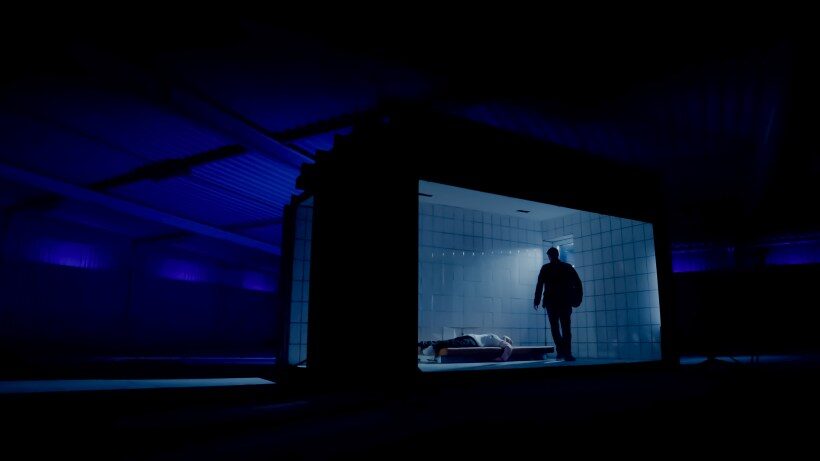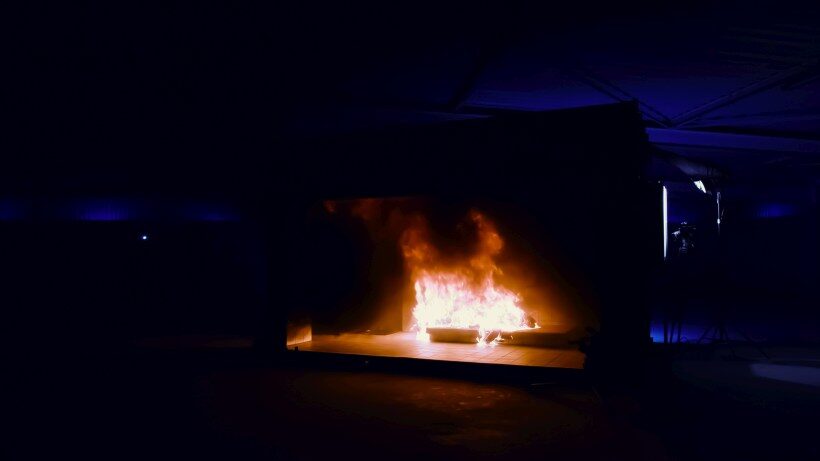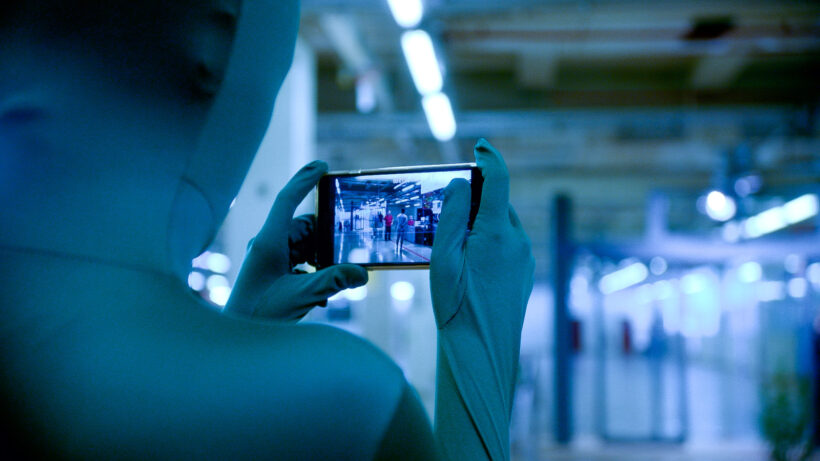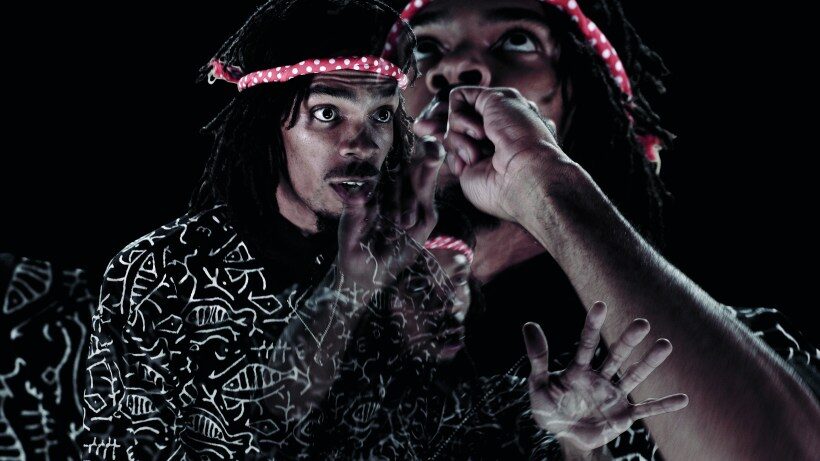
CELL 5 © blackboardfilms
The experimental setup is gruesome: a minimal space consisting of perhaps four square meters. Tiled on the inside, with a pane of glass to view through, and a basic foam mattress covered in imitation leather on the floor. This was roughly how the police cell looked, in which the asylum seeker Oury Jalloh burned to death in 1992 in the police station in Dessau-Roßlau. How can a person who was bound by his hands and his feet set himself on fire? Because this question could still not be clarified even after conducting investigations for many years and releasing three official reports, the artist Mario Pfeifer resolved to pursue it further.
“Ultimately, a person was burnt to death in that cell, and there has never been a court ruling on it,”, he says, regarding this as a fatal omen. “Our civil society should not accept this.”
Mario Pfeifer, born 1981 in Dresden, is a filmmaker who takes things on which cause the society to fail. He rented an entire aircraft hangar in Babenhausen, Hesse, rebuilt the police cell true to its original, worked through the case files and engaged the English fire expert Iain Peck, who reconstructed the fire and analyzed it. The artistic documentary CELL 5 lasts 30 minutes, as long as the life-sized dummy, which was first covered in flammable liquid and then set alight, took to burn. Also as long as Oury Jalloh must have died a horrific death in his cell. The re-enacted cell set was constructed in such a way that it was sufficient to endorse a forensic expert opinion and be valid in a court of law.
“What I’d really like is for the audiences to realize the level of violence that occurred there,” Pfeifer explains.

CELL 5 © blackboardfilms
Participating in this experiment feels like an almost physical experience. With black waves of noise against a black background. Pfeifer depicts his protagonist in contrast to the darkness, thereby creating a multilayered film that goes far beyond the documentary. At the press conference for the film, held in a darkened room, during which the results of the experiment were presented to his relatives, as well as to the “Initiative in Memory of Oury Jalloh,” the director interwove original quotes from the employees of the police station, documenting the atrocity on the day it occurred.
“The colleague will be down there in a bit,”
says an expressionless female voice over the intercom that was directly connected to Oury’s cell, as though this just concerns an everyday banality. Later on, she is not sure whether she should call the fire department or an ambulance. The lay actors embody the lack of empathy here in a frighteningly real way. It is a self-contained, aesthetically high-quality revivification of something incomprehensible. Then, Pfeifer even introduces a third level. The actress Dennenesch Zoudé guides the audience through the film as an uninvolved narrator, presenting a result that says much about the zeitgeist in the 1990s. The death of Oury Jalloh has inscribed itself in the collective memory of the post-reunification period in East Germany. And with it, Pfeifer attracted 25,000 visitors to the Bundeskunsthalle venue last year when he presented the film there. In 2023, CELL 5 was awarded the Hessen Film Prize in Frankfurt am Main.
Even if Mario Pfeifer does not consider himself to be a political artist, time and again he finds himself at that place where the judiciary and the executive through their voicelessness fail to achieve progress.
“My art is the resonance chamber for the society that I live in,” he says.

AGAIN © blackboardfilms
In AGAIN (2018), he adopted a similar approach to that in CELL 5 and reconstructed the “Arnsdorf” case, in which an asylum seeker was tied to a tree with cable ties by the residents of a village in East German Saxony. Yet again, he fictionalized in an imaginary place what had really happened. Using a kind of underground parking garage, actors reenacted the scene that began in a supermarket, and which went viral because of a cell phone video. Once more, multiple narrative voices were utilized, with the actors Mark Waschke and Dennenesch Zoudé thematizing civil courage.
“So why does no one do anything?”
when a man with darker skin is overpowered by three men. How would you have behaved when the men tied him to a tree? In AGAIN, Pfeifer’s experimental setup is further expanded by observing members of the public – people with a migration background who have experienced racism and exclusion themselves. As recipients, they are observing, just like the audience itself, directly at the place where the events occurred. At the end, Mario Pfeifer weaves their thoughts into the film and accords it a meta level that goes far beyond the mere horror at the brutalization of human interactions. Their views reveal an inner perspective on racism in Germany, on the failure of the state and civil society, which were no longer capable of providing for the asylum seeker from Iraq in question. Several months after the atrocity, he was found dead in the woods near the asylum seekers’ home.
In Pfeifer’s filmic experiments, nothing is left to chance. Reality is reenacted, revisualized and expanded on various levels. Moreover, he incorporates perspectives and viewpoints that were previously not visible at all – a style that has recurred in his works from the very beginning.
“Film is my way of getting in contact with this world out there,”
he explains. Mario Pfeifer initially studied photography at the HGB Academy of Fine Arts in Leipzig. However, he soon realized that film was his medium of choice. Artists like Bruce Naumann, Jeff Wall or Ingmar Bergmann proved to be an inspiration for him. He went on to study at the University of the Arts in Berlin, the Städelschule art school in Frankfurt am Main, and the Institute of Arts in California. And he has shot films in India, Chile, and the USA. With his works, he meanders along the interface between film and art. Commencing with the location of an occurrence, he explores political, cultural, and aesthetic viewpoints, connecting everything with everything else.
For his work APPROXIMATION IN THE DIGITAL AGE TO A HUMANITY CONDEMNED TO DISAPPEAR, he travelled to Chile in 2015 and found lodgings in a room with neither water nor electricity directly beside an indigenous reserve. Over time, he managed to establish contact with the Yaghan, the indigenous people of Chile. He showed them pictures from an ethnological collection, confronting them with their own fate, their uprootedness. For not only had they been robbed of their homeland, even their centuries-old cultural techniques had become lost.
“It became a film in which everything changed, in which a nation actually perished because they did not find any weapons to defend themselves with,”
Pfeifer comments. For the film, he chose three parallel projection surfaces to reflect on the past and the present.
“It was important for me to create a multi-perspectivity,”
Pfeifer explains. He also calls this democratic looking. Because the audience are permitted to choose what their eyes may linger upon. He already played with the simultaneity of information in A FORMAL FILM IN NINE EPISODES from 2010. At that time, the audience even had to go from one museum to another one in order to see the whole film.
“Yet for that, the film does purport to have a narrative that you have to discover for yourself,”
Pfeifer says. This was his first work to be acquired by a museum.
APPROXIMATION consists of three monitors in the same space. People in white plastic suits are standing at an assembly line, sorting seafood. Animals are being cut up and packaged mechanically for transportation, brutally and inhumanely – the crabs that the indigenous people once used to pick themselves by hand from the seabed. It is industrialization made visible, running its course without a sound. Elsewhere in the film, an animal’s head is meticulously chopped up with an axe. His stylistic element in APPROXIMATION consists of contrasts, with the new here and the old there. People clad only in the bare necessities, standing in the jungle, photographs of the Yaghan in black and white, followed soon by nature turned into concrete, deserted.
For the soundtrack, he took songs and sounds of the indigenous tribe from the last century and combined them with techno. As such, digitality forms the connecting element between the worlds. APPROXIMATION is an intensive work that resonates. And as Pfeifer himself says, his films consist of resonance chambers in the society within which he lives. With much being accorded sound there.
In the same way that he approaches places and people he wants to consider and recount, he also acts as an ethnologist, constructing and deconstructing the familiar and the foreign – such as in On Fear and Education, Disenchantment and Justice, Protest and Disunion in Saxony / Germany, a mammoth work in two parts from 2016: 546 minutes of film footage, in which people only talk. The camera is close up on their faces, with no other influencing factors, just the eye contact and the spoken word. And he articulates himself less visually here than is the case in his other works.
Shortly after the founding of the Dresden-based, far-right Pegida (Patriotic Europeans Against the Islamization of the West) movement to curb immigration into Germany, Pfeifer was commissioned by the Galerie für Zeitgenössische Kunst in Leipzig gallery to seek contact with those who had founded the movement, were close to it or were able to explain it. He spoke to a mayoress, a schoolteacher, and a conflict researcher – with it all again concerning complexity.
“What I’d like is for us to engage with these people,”
he explains,
“that we’re even able to nail them down on this.”
This is the only way that they can also be held accountable. They recount personal stories involving upheavals and rejections, as indeed betrayals of confidence and global politics. This functions as a kaleidoscope of opinions and personal anecdotes, as an attempt at explanations in a time when the far-right AfD political party was still in its infancy and some people dismissed Pegida as a temporary phenomenon.
“That really was the social discourse at that time, and we had to face it,”
Mario Pfeifer says in retrospect. For him, the film was also a kind of sociological study of East Germans. And even if the listening this entailed was not always easy for him, it was still necessary. Making a film like that is barely feasible today, Pfeifer explains. This work can also be seen in the Bundeskunsthalle venue in 2024.
Pfeifer’s works have long been acclaimed in the international art world. In addition to Germany, he has already been exhibited in Switzerland, the USA, and Chile. His films have been screened at international festivals, such as the IDFA, DOK Leipzig or the Hof International Film Festival. He was a Fulbright and DAAD scholarship holder, and his works can be found in private and public collections in Europe and North America, such as, for instance, in the MMK Museum für Moderne Kunst in Frankfurt am Main, the Dresden State Art Collections, and the Fotomuseum Winterthur.

#BLACKTIVIST © blackboardfilms
Pfeifer moves between these worlds, with film here and art there, or even both together. And this is what makes his work so unique. Also because he is prepared to enter the exact world that he wants to reveal. Such as in #BLACKTIVIST, which he worked on in 2015 with rappers in the USA and produced a music video together with them that has clocked up 3.8 million views on YouTube so far. Here, too, he worked with parallel projections and provocative images. Pfeifer is not someone who leaves out or omits that which is difficult or challenging. In his next project, he intends to explore artificial intelligence.
featured image CELL 5 © blackboardfilms